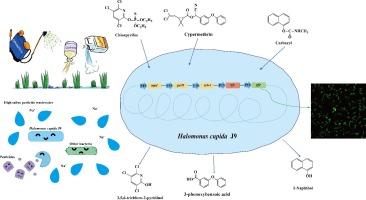Chemical Engineering Journal ( IF 15.1 ) Pub Date : 2024-04-16 , DOI: 10.1016/j.cej.2024.151389 Weini Xiong , Hongfu Guo , Yujie Liu , Yan Meng , Yuting Jiang , Bingzhi Li , Ruihua Liu , Chao Yang

|
The biotreatment performance of high saline wastewater containing multiple pesticides is significantly reduced because the growth and metabolism of activated sludge microbial communities are severely impaired by high osmotic pressure and joint toxicity of multiple pesticides. In this study, Halomonas cupida J9 was metabolically engineered by chromosomal integration of three different pesticide hydrolase genes, to create a halotolerant multi-pesticides degrader. In batch degradation experiments, the finally constructed strain J9U-PVG was able to simultaneously degrade chlorpyrifos (organophosphate), carbaryl (carbamate) and α-cypermethrin (pyrethroid) in mineral salt medium supplemented with 4 g/L glucose and 60 g/L NaCl. Total cell lysate of J9U-PVG showed obvious degradation activity against chlorpyrifos, carbaryl and α-cypermethrin. Moreover, introduced Vitreoscilla hemoglobin (VHb) can enhance oxygen-sequestering capability of J9U-PVG and introduced green fluorescent protein (GFP) can be used as a biomarker to track the activity and movement of J9U-PVG in natural environments. More importantly, J9U-PVG could simultaneously and completely degrade chlorpyrifos, carbaryl and α-cypermethrin in high saline river water. Here, we demonstrate for the first time the successful construction of a halotolerant multi-pesticides degrader. This study underscores the value of H. cupida J9 as a promising chassis for the development of a halotolerant pesticide bioremediation platform. In the future, synthetic biology may serve as a powerful tool for expanding the catalytic repertoire of extremophiles for bioremediation of extreme environments.
中文翻译:

用于废水处理的耐盐多农药降解剂的开发
由于活性污泥微生物群落的生长和代谢受到高渗透压和多种农药联合毒性的严重损害,含有多种农药的高盐废水的生物处理性能显着降低。在这项研究中,Halomonas cupida J9 通过染色体整合三种不同农药水解酶基因进行代谢工程,以创建耐盐多农药降解剂。在批量降解实验中,最终构建的菌株J9U-PVG能够在添加4 g/L葡萄糖和60 g/L NaCl的矿物盐培养基中同时降解毒死蜱(有机磷)、甲萘威(氨基甲酸酯)和α-氯氰菊酯(拟除虫菊酯) 。 J9U-PVG的总细胞裂解液对毒死蜱、西维因和α-氯氰菊酯表现出明显的降解活性。此外,引入的玻璃颤菌血红蛋白(VHb)可以增强J9U-PVG的氧隔离能力,并且引入的绿色荧光蛋白(GFP)可以用作跟踪J9U-PVG在自然环境中的活性和运动的生物标志物。更重要的是,J9U-PVG可以同时完全降解高盐度河水中的毒死蜱、西维因和氯氰菊酯。在这里,我们首次展示了耐盐多农药降解剂的成功构建。这项研究强调了H. cupida J9 作为开发耐盐农药生物修复平台的有前途的基础的价值。未来,合成生物学可能成为扩展嗜极微生物催化能力的强大工具,用于极端环境的生物修复。



























 京公网安备 11010802027423号
京公网安备 11010802027423号